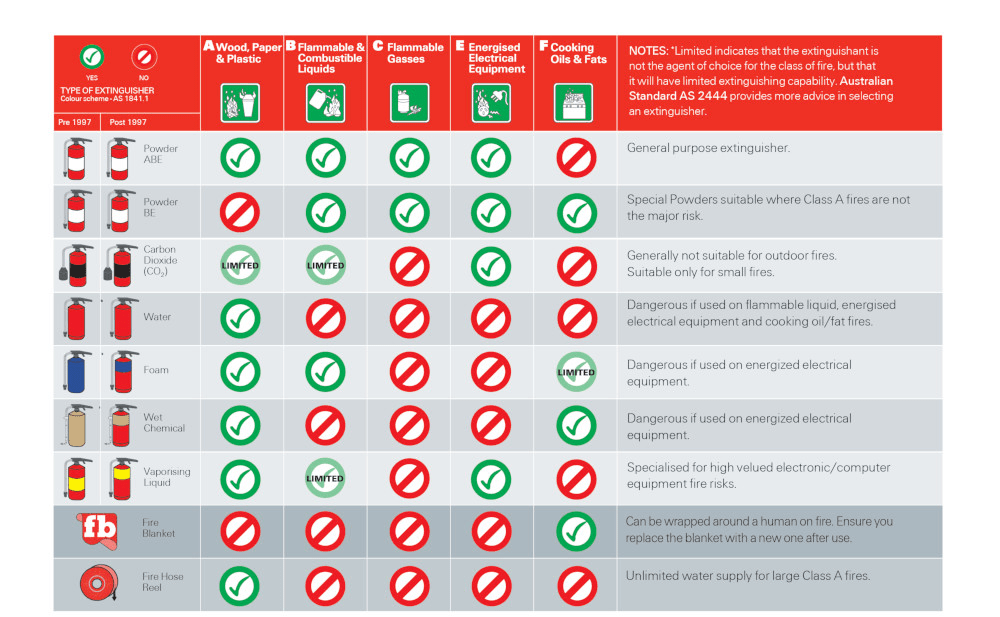FIRE SAFETY
A fire is one of the biggest hazards on a marine craft, any indication of fire is assumed immediately to be a sign of distress due to the risk to the people onboard who have limited means of escape.
The three main causes of fire on a boat are;
- The Galley
- The Marine Engine
- Electrical
It is important that as many crew on the boat understand the risk of fire, the types of fire extinguishers used to manage the fire, and importantly are trained on how to use them.

Not all fire extinguishers are created equal. A fire extinguisher that is best for one type of fire can actually make a different fire worse. For a marine diesel engine fire, the best would be to use a powder type extinguisher
although a foam type will work if that is what you have on board. A responsible, well prepared skipper should ensure that they have all the required extinguishers for the potential fires on board. Carbon dioxide extinguishers would not be recommended given the enclosed space
and the asphyxiant nature of Carbon Dioxide. Unless you have fresh air yourself, taking the air out of the cabin is not going to save your life if you can not get outside to breathe.
A dry chemical extinguisher can be identified by a white band around the extinguisher, and the correct powder extinguisher is also compatible with galley fires. It would not be considered wise or prudent to carry only one extinguisher on board.
It is best to carry multiple extinguishers that are compatible with the widest possible range of likely fire types. You also need to ensure that your extinguisher is in service date and still has charge. Check the gauge on the extinguisher
at least once a month and have it recharged if the gauge shows red or low pressure.
Engine Fires
Marine Engine fires have a special consideration as the engine itself is usually in a closed compartment. This has the benefit that the air supply to the fire is limited and therefore restricting the size of the fire. However if you open the hatch to get to the fire, you will cause an increase in air flow which will feed the fire making the situation worse.
It is worth considering installing a smoke detector in the engine bay to alert you to a potential engine fire. The earlier you respond, the more chance you have of controlling it. To deal with engine fires, vessel manufacturers have considered a number of fire fighting options:
The Hole Into the Engine Bay
The simplest, least expensive, easiest to maintain and by far the most common is the hole in the hatch. If you have an engine fire, simply poke the extinguisher through the hole and empty it completely into the engine bay. An extinguisher works by removing the oxygen supply that fuels the fire and also cooling the surfaces.
As the fire is contained when the hatch is closed, it is the best time to put out fire due to the limited fresh air supply. If your boat does not have an extinguisher hole, it is a simple matter to put one in and is thoroughly recommended.
Do not try to keep some of the extinguisher in reserve to use if there is still a fire when you open the hatch, as once it is opened, any residual fire will have fresh air and become much harder to put out.
By using the entire contents of the extinguisher you are maximising its effectiveness in removing the air supply.
Fixed Fire Extinguishers in the Engine Bay
These are more commonly found on larger yachts, and commercial vessels with much larger engine bays. But they are not uncommon. They have the key benefit in that they do not expose crew to the hazards of fighting the fire and are much faster in putting out the fire.
The fixed systems are also usually specifically designed for the space of the engine bay with reserve and so are more likely to ensure the fire is put out.
There are two different versions. Manual activation and automatic activation.
- Manually activated ones require one of the crew to actually put out the fire. This is either by a solenoid and a remote pushbutton, or a mechanical triggering device that you can access outside the engine bay.
- Automatic activation ones use a trigger such as one from a smoke detector and an electric solenoid to activate it, or a flammable string that once ignited will break and cause the extinguisher to activate it.
Even boats with fixed fire extinguishing systems, you still need to have a manual extinguisher available should the automatic system not work, and a hole into the engine bay is still a great way to deliver the extinguishant.
Most manufactures are now also installing some degree of passive fire protection inside the engine bay.
This protection is not to contain or control the fire, but to increase the time available for you to fight the fire before it gets out of control.